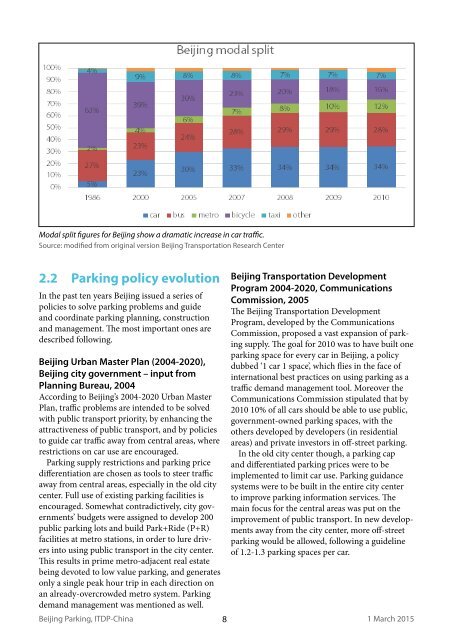Beijing-parking-ITDP-China
Beijing-parking-ITDP-China
Beijing-parking-ITDP-China
Create successful ePaper yourself
Turn your PDF publications into a flip-book with our unique Google optimized e-Paper software.
Modal split figures for <strong>Beijing</strong> show a dramatic increase in car traffic.Source: modified from original version <strong>Beijing</strong> Transportation Research Center2.2 Parking policy evolutionIn the past ten years <strong>Beijing</strong> issued a series ofpolicies to solve <strong>parking</strong> problems and guideand coordinate <strong>parking</strong> planning, constructionand management. The most important ones aredescribed following.<strong>Beijing</strong> Urban Master Plan (2004-2020),<strong>Beijing</strong> city government – input fromPlanning Bureau, 2004According to <strong>Beijing</strong>’s 2004-2020 Urban MasterPlan, traffic problems are intended to be solvedwith public transport priority, by enhancing theattractiveness of public transport, and by policiesto guide car traffic away from central areas, whererestrictions on car use are encouraged.Parking supply restrictions and <strong>parking</strong> pricedifferentiation are chosen as tools to steer trafficaway from central areas, especially in the old citycenter. Full use of existing <strong>parking</strong> facilities isencouraged. Somewhat contradictively, city governments’budgets were assigned to develop 200public <strong>parking</strong> lots and build Park+Ride (P+R)facilities at metro stations, in order to lure driversinto using public transport in the city center.This results in prime metro-adjacent real estatebeing devoted to low value <strong>parking</strong>, and generatesonly a single peak hour trip in each direction onan already-overcrowded metro system. Parkingdemand management was mentioned as well.<strong>Beijing</strong> Transportation DevelopmentProgram 2004-2020, CommunicationsCommission, 2005The <strong>Beijing</strong> Transportation DevelopmentProgram, developed by the CommunicationsCommission, proposed a vast expansion of <strong>parking</strong>supply. The goal for 2010 was to have built one<strong>parking</strong> space for every car in <strong>Beijing</strong>, a policydubbed ‘1 car 1 space’, which flies in the face ofinternational best practices on using <strong>parking</strong> as atraffic demand management tool. Moreover theCommunications Commission stipulated that by2010 10% of all cars should be able to use public,government-owned <strong>parking</strong> spaces, with theothers developed by developers (in residentialareas) and private investors in off-street <strong>parking</strong>.In the old city center though, a <strong>parking</strong> capand differentiated <strong>parking</strong> prices were to beimplemented to limit car use. Parking guidancesystems were to be built in the entire city centerto improve <strong>parking</strong> information services. Themain focus for the central areas was put on theimprovement of public transport. In new developmentsaway from the city center, more off-street<strong>parking</strong> would be allowed, following a guidelineof 1.2-1.3 <strong>parking</strong> spaces per car.<strong>Beijing</strong> Parking, <strong>ITDP</strong>-<strong>China</strong> 81 March 2015


